Ever wondered how Steve Jobs turned Apple into a global sensation? It’s not just about sleek gadgets; it’s about crafting a legacy. Jobs’ relentless vision and innovative spirit morphed Apple from a garage startup into a tech titan.
Let’s dive into the magic formula.
Visionary Leadership: Jobs didn’t just run a company; he led a movement. Collaborating with design genius Hartmut Esslinger, he redefined Apple’s look with simplicity and elegance. 🌟
Emotional Marketing: Jobs’ storytelling was legendary. He didn’t sell products; he sold dreams. His keynotes were like rock concerts, and each product unveiling felt like a chapter in a grand narrative. 🚀
User-Centric Design: Apple products aren’t just user-friendly; they’re user-obsessed. This focus on intuitive design builds fierce loyalty. Think about the first time you swiped an iPhone—pure magic. ✨
Attention to Detail: Jobs’ meticulous eye for detail kept Apple ahead of the curve. From the tiniest icon to the unboxing experience, nothing was left to chance. 🎯
Long-Term Vision: Jobs always had one eye on the future. His ability to foresee trends and pivot Apple accordingly kept the brand at the cutting edge of technology. 🔍
Want to dive deeper into these strategies and apply them to your brand? Imagine the possibilities of creating your own cult-like following.
Ready to transform your brand? Book a consultation call today and let’s make your brand legendary too. 🚀
Visionary Leadership
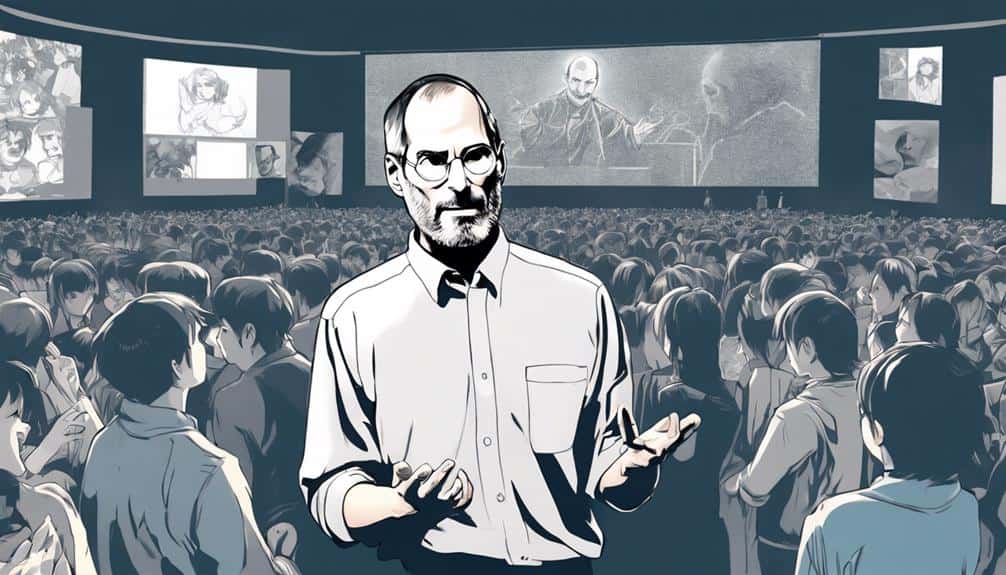
Ever wondered how a struggling tech company became a global icon? Steve Jobs’ visionary leadership made that magic happen for Apple. His genius wasn’t just in creating products; he crafted an ideology that transformed Apple into more than a brand—it became a movement.
Jobs’ unique personality infused Apple’s early days with an aura that many call the ‘cult of Apple.’ This wasn’t just about gadgets; it was about thinking different and being part of something special. ✨
After Jobs passed away in 2011, the world grieved not just for a CEO, but for a visionary whose influence was almost mythic. His minimalist design philosophy and tech spiritualism fueled this almost cult-like devotion. People didn’t just buy Apple products; they bought into Jobs’ vision of simplicity and elegance. 🍏
Jobs’ leadership created a sense of belonging and identity among Apple users. Through strategic branding and his charismatic persona, he turned customers into loyal followers. The cult of Apple was no accident; it was a calculated outcome of Jobs’ leadership and marketing genius. His legacy continues to influence how we think about technology and innovation.
Feeling inspired? Curious about how visionary leadership can transform your brand? Let’s chat! Book a consultation call today to explore how we can elevate your branding and digital marketing strategy.
Ready to start your journey to becoming the next big thing? 🚀
Innovative Design
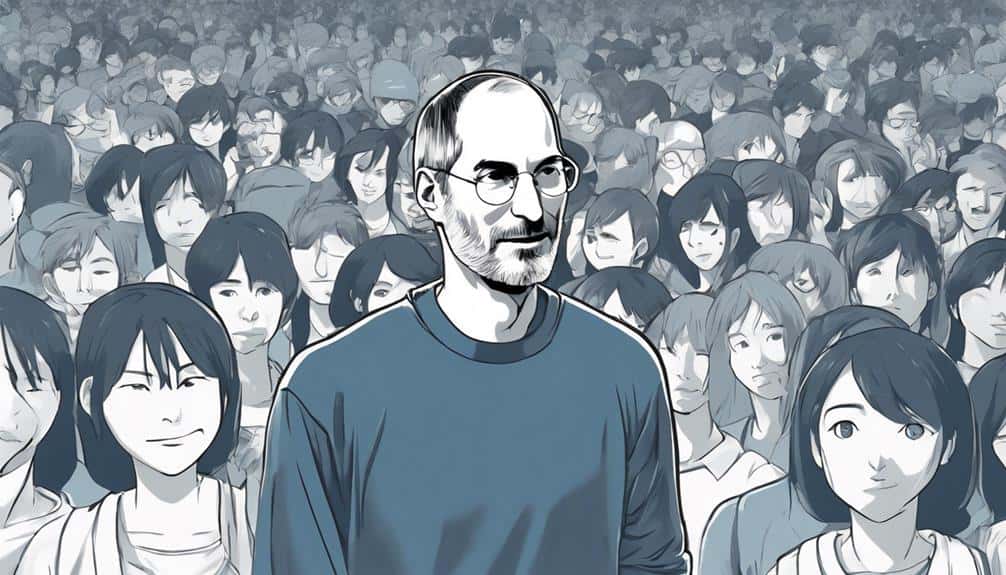
The Design Revolution that Shaped Apple: A Deep Dive into Hartmut Esslinger’s Legacy
Imagine a world where Apple products didn’t just look good but felt like an extension of yourself. That’s exactly what happened when Hartmut Esslinger joined Apple in 1982, revolutionizing the company’s design strategy. His innovative Snow White design language set new industry standards, emphasizing sleek lines, modern aesthetics, and functional elegance. It wasn’t just about making things pretty; it was about marrying form with function to create an unforgettable user experience.
Esslinger’s work didn’t just stop at Apple. His designs earned spots in prestigious museums like the Whitney Museum and MoMA, cementing his influence on both the tech industry and the art world. Collaborating with Steve Jobs, Esslinger extended his design philosophy to NeXT in 1985, showcasing his lasting impact on Jobs’ ventures.
| Year | Event | Impact on Apple |
|---|---|---|
| 1982 | Esslinger joins Apple | Revamped design strategy |
| 1985 | Esslinger follows Jobs to NeXT | Continued design influence |
| 2023 | Esslinger’s work in MoMA & Whitney | Highlights cultural and design impact |
Esslinger’s vision for Apple’s future—returning to classic design values while leading in digital consumer technology—underscores his commitment to long-term innovation. By blending design with cutting-edge tech, Apple didn’t just set industry standards; it became a cultural phenomenon, influencing the tech world and beyond.
With his recommendations for Apple, Esslinger reminds us that innovation isn’t just about the latest gadget but about creating something that resonates on a deeper level. Imagine if your brand could do the same. How could you blend aesthetics, functionality, and user experience to set new standards in your industry?
Ready to revolutionize your brand? Let’s chat! Book a consultation call today and let’s make your brand the next big cultural phenomenon. 🚀
Compelling Storytelling
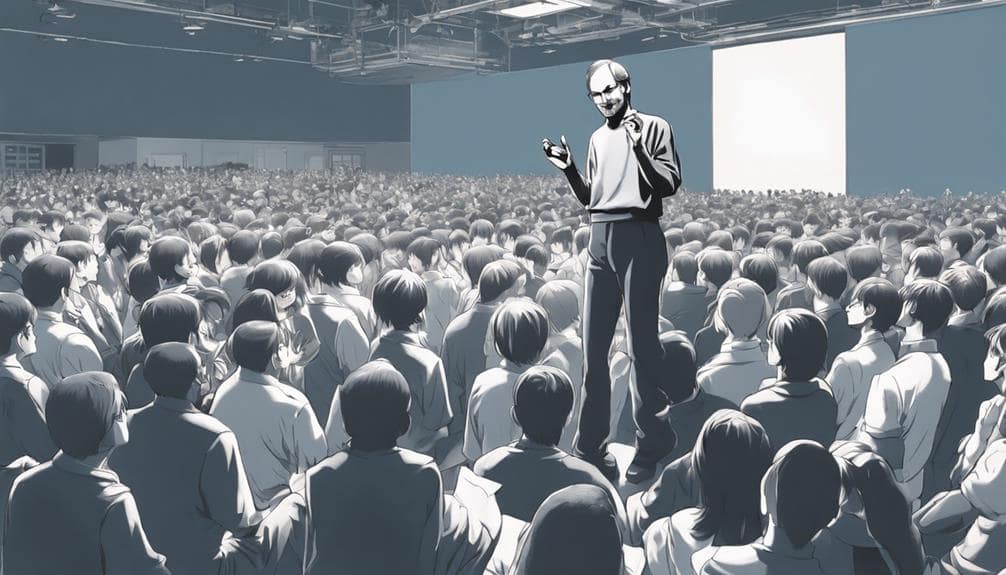
Imagine this: A product launch so thrilling it feels more like a rock concert than a tech event. Steve Jobs had this magical ability to turn mundane product unveilings into epic experiences. But what was his secret sauce? 📱
Hartmut Esslinger’s design transformation laid the groundwork, but it was Jobs’ commanding storytelling that truly built a cult-like following around Apple. Jobs had a remarkable gift for connecting with consumers through engaging narratives, seamlessly blending his personal journey with Apple’s story.
His storytelling wasn’t just about moving units; it was about selling a vision that resonated deeply. Each Apple product wasn’t just another gadget; it was a groundbreaking innovation. Jobs’ presentations made people feel like they were part of something monumental. Every launch felt like a milestone, not merely an upgrade.
Empirical data shows brand loyalty soared under Jobs’ leadership. His narrative strategy fostered a sense of belonging and identity within the Apple community. This wasn’t just a tech company; it was a movement. Consumers didn’t just buy iPhones or Macs; they bought into a lifestyle and a vision.
Jobs’ storytelling emphasized Apple’s innovative spirit and design philosophy, captivating audiences and reinforcing their loyalty. It created emotional bonds, transforming ordinary customers into passionate followers. This emotional connection is what turned Apple into a cultural icon.
Ready to craft your brand’s narrative and build a cult-like following? Book a consultation call today and let’s make your story unforgettable. 📝
User-Centric Products
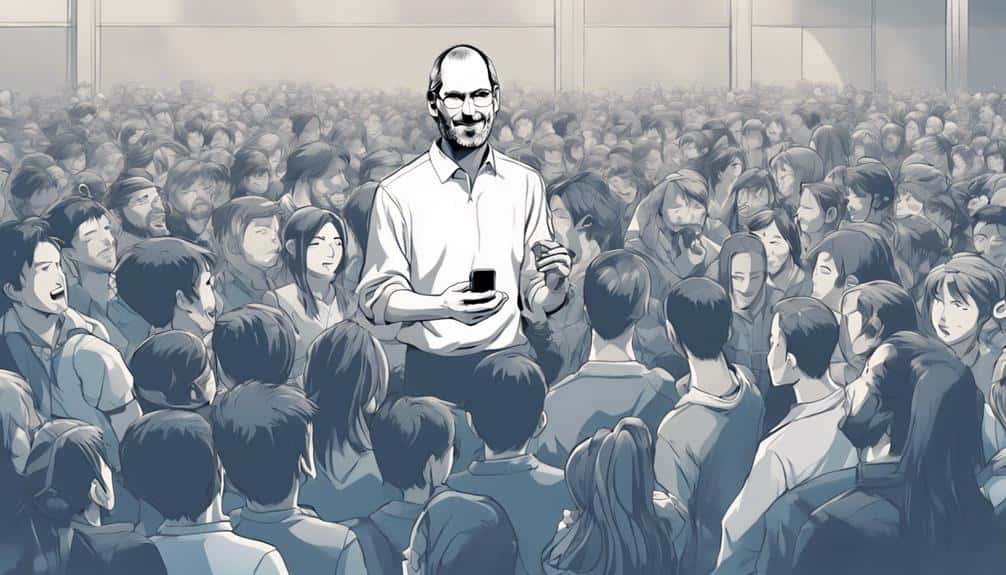
Ever wondered what makes Apple so wildly successful? It’s all about their obsessive focus on user-centric design. Steve Jobs revolutionized the consumer electronics industry by always putting the user first. This approach gave birth to legendary products like the iPod, iPhone, and iPad, each crafted to meet specific customer needs.
So, what’s the magic sauce behind Apple’s user-centric approach? Let’s break it down:
- Intuitive Interfaces: Apple nails simplicity. Their products are so user-friendly that even your grandma can navigate them. This ease of use reduces frustration and makes tech accessible for everyone.
- Seamless Ecosystem: Apple’s products talk to each other like best friends. Sync your iPhone with your MacBook or use AirDrop to share files effortlessly. This interconnectedness adds massive value and convenience.
- Emotional Connection: Apple doesn’t just sell gadgets; they sell experiences. Their focus on user-centric design creates products that resonate on a personal level, fostering loyalty and repeat purchases.
Imagine the power of these principles applied to your brand. Ready to elevate your digital marketing game? Let’s chat. Book a consultation with me today, and let’s create something extraordinary together.
Brand Loyalty
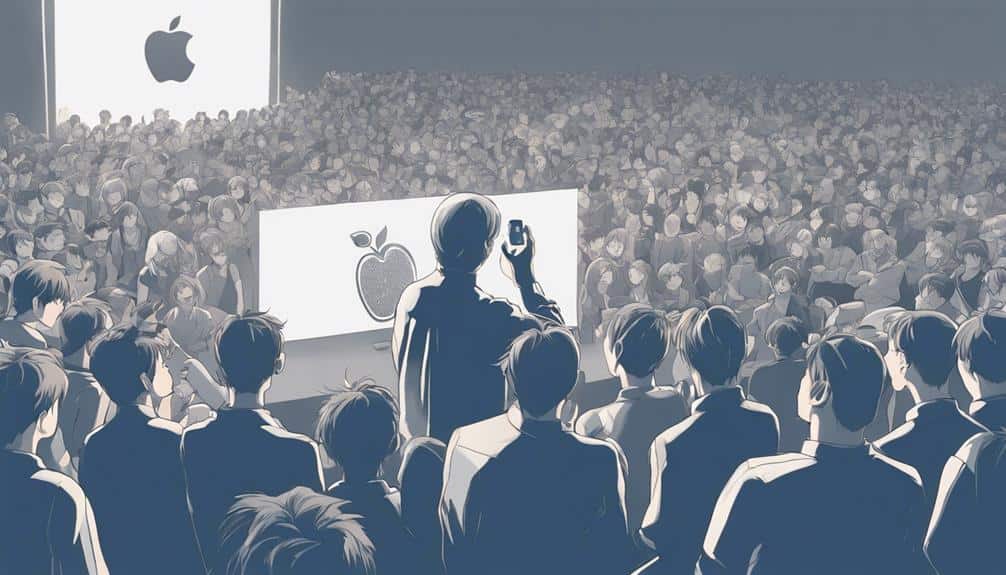
Apple’s Brand Loyalty: A Modern Phenomenon
Ever noticed the unwavering devotion of Apple fans? It’s like they’re part of some high-tech cult. The emotional connection Apple fosters through its user-centric products has created a level of brand loyalty that’s nothing short of fascinating.
When Steve Jobs passed away, memorial shrines popped up at Apple Stores across the globe. These tributes weren’t just about mourning a tech visionary; they underscored a deep emotional bond between the brand and its users.
Messages at these memorials often hailed Jobs as a true world-changer. His vision struck a chord with people on a deeply personal level. This is brand loyalty on steroids. In fact, the term ‘cult of Apple‘ gets more search engine hits than many actual new religious movements combined. It’s a testament to the sheer fascination and dedication of Apple’s followers.
The ‘cult of Apple’ isn’t just a catchy phrase. It embodies qualities like individualism and progressivism, making Apple a unique symbol in modern consumer culture. Users see Apple as more than just a tech company; it’s a beacon of innovation and forward-thinking. This connection is why Apple remains not just influential but beloved.
Feeling intrigued? Let’s dive deeper into what makes Apple’s branding so effective and how you can apply these strategies to your own business. Book a consultation call today, and let’s create your next success story!
Challenging the Status Quo
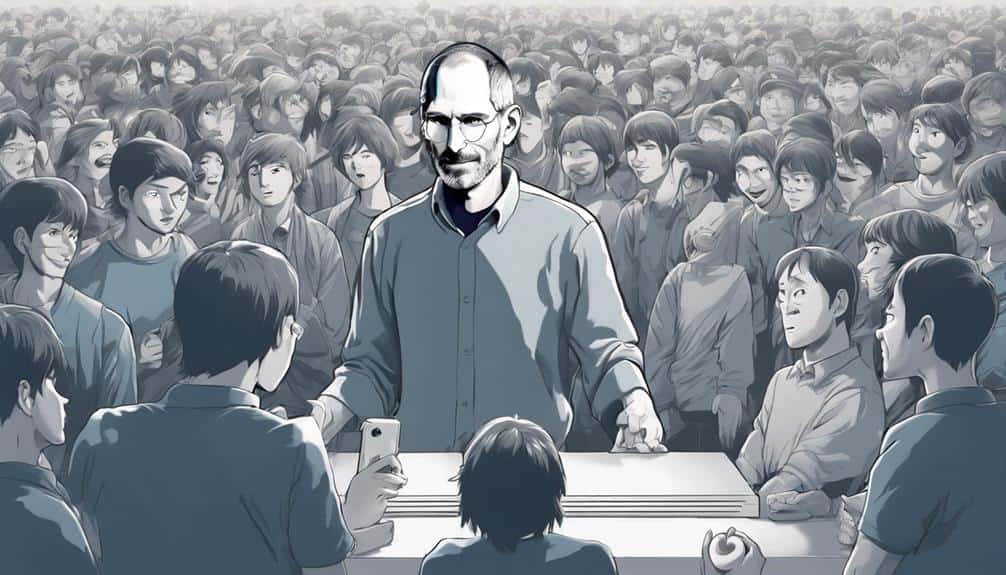
Redefining Tech Design: When Steve Jobs Broke Away from the Norm
Steve Jobs didn’t just question the status quo—he shattered it. Teaming up with designer Hartmut Esslinger, Jobs transformed Apple’s identity through the revolutionary Snow White design language. This collaboration was a game-changer, setting Apple on a path to extraordinary innovation and market dominance.
Jobs knew that to stand out, Apple had to ditch the conventional tech design. Here’s how he did it:
- Visionary Designer Collaboration: Jobs and Esslinger revolutionized Apple’s design philosophy. With the Snow White design language, they introduced a sleek, modern aesthetic that instantly captivated consumers.
- Aesthetic Appeal: Thanks to Esslinger, Apple’s products weren’t just functional; they were visually stunning. This emphasis on aesthetics forged a deeper emotional bond with users, making Apple products irresistible.
- Commitment to Innovation: Jobs’ relentless pursuit of cutting-edge technology meant Apple was always ahead. By merging design with innovation, Apple didn’t just follow trends—they set them.
Jobs’ strategy wasn’t about being different for the sake of it. It was about being the best. His vision ensured Apple led the tech industry, not just participated in it.
Want to elevate your brand like Apple did? Let’s talk! Book a consultation call today and let’s turn your brand into the next big thing.
Simplicity and Elegance
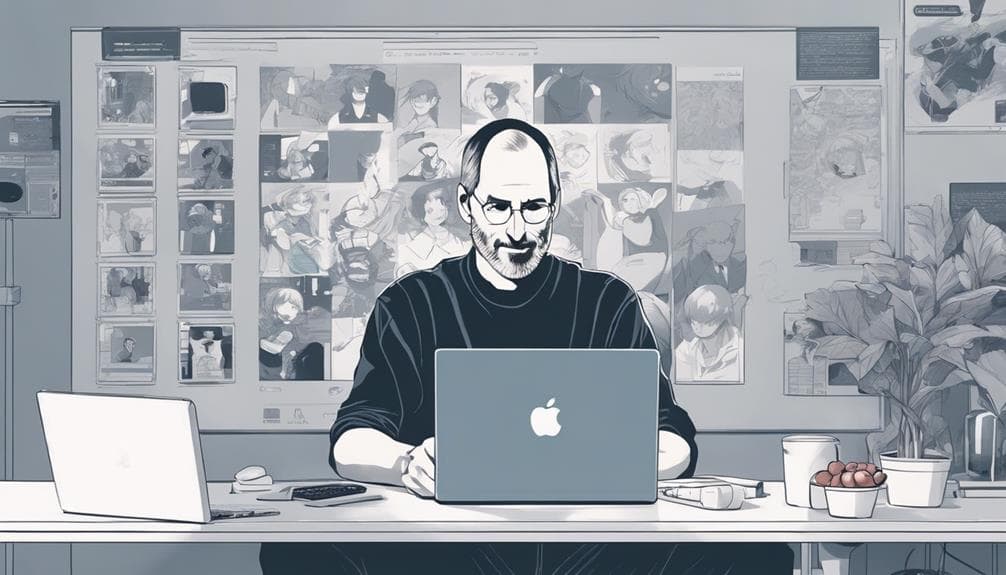
Ever wondered why Apple’s products just feel… right? The secret lies in their embrace of simplicity and elegance.
Apple’s journey towards ultimate user satisfaction and loyalty is rooted in a powerful design philosophy known as ‘Snow White,’ developed by Hartmut Esslinger. This approach, marked by clean lines and minimalism, hasn’t only become synonymous with Apple’s iconic aesthetic but also earned them a place in revered institutions like the Whitney Museum and MoMA.
Steve Jobs’ vision played a crucial role in adopting and perfecting this design ethos. Jobs believed that products should be both functional and visually captivating. By prioritizing simplicity, he ensured that Apple devices remained intuitive and user-friendly. Data supports this, showing a significant boost in Apple’s customer satisfaction rates.
Esslinger’s advice to Apple—centered on classic design values and leading-edge digital technology—aligned seamlessly with Jobs’ vision. He urged Apple to innovate in television, audio, and communication, areas where simplicity and elegance could truly shine. This strategic focus allowed Apple to create high-performing yet beautifully designed products, fostering a fiercely loyal customer base.
Apple’s unwavering commitment to simplicity and elegance, championed by Jobs and Esslinger, has been pivotal to its enduring success.
Curious to see how these principles can transform your brand? Let’s chat. Book a consultation call today and let’s craft your path to success.
Marketing Genius

Apple’s marketing mastery isn’t just about sleek product design; it’s about crafting stories that stick. Steve Jobs recognized that a product’s value hinges on its narrative, and Apple has nailed the art of storytelling. They don’t just sell devices; they sell emotions and dreams. ✨
Remember the iconic ‘1984’ Super Bowl commercial? Directed by Ridley Scott, it didn’t just introduce the Macintosh—it declared Apple a revolutionary force. Then there’s the ‘Think Different’ campaign featuring legends like Albert Einstein and John Lennon, which encapsulated Apple’s core values of innovation and creativity.
To grasp Apple’s marketing genius, let’s break down three key strategies:
- Emotional Storytelling: Apple’s iPod silhouette ads are a masterclass in evoking emotions. They resonate deeply and create lasting impressions.
- Iconic Imagery: With minimalist design in products and packaging, Apple champions simplicity and elegance, reinforcing its unique brand ethos.
- Cultural Impact: Campaigns like ‘Think Different’ link Apple with visionaries, elevating the brand from a tech company to a cultural icon.
These strategies show how Steve Jobs built a brand that sells not only products but also a lifestyle and a vision.
Apple has proven that great marketing is about creating emotional connections, not just transactions.
Want to turn your brand into a cultural icon? Let’s chat about how we can craft your own compelling narrative. Book a consultation call now and let’s make your brand unforgettable! ✨
Consistent Excellence
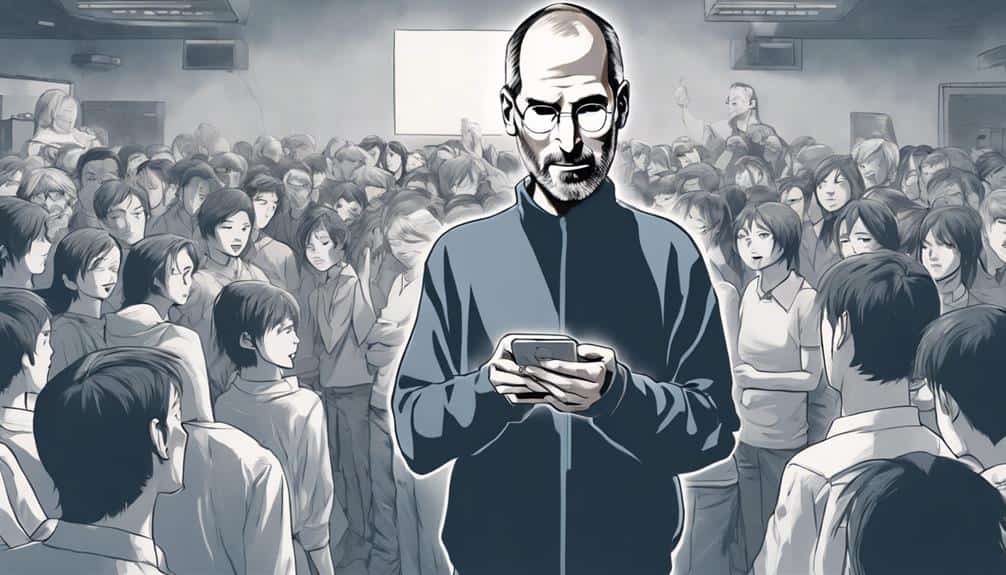
Steve Jobs’ laser-focused vision on crafting exceptional user experiences turned Apple into the gold standard for consistent excellence in tech. This isn’t just marketing fluff. Every Apple product launch is a masterclass in attention to detail and groundbreaking innovation.
Step into an Apple Store, and it’s not just a retail space. You’re entering a meticulously crafted environment that screams Apple’s dedication to quality and design. From the sleek product displays to the seamless customer service, every element reflects Apple’s relentless pursuit of perfection.
Data backs this up. Apple’s customer satisfaction ratings consistently outshine its competitors. This didn’t happen by chance. Jobs pushed the boundaries of what’s possible in tech and design, cementing Apple’s reputation for excellence.
By focusing on making products that aren’t just functional but also beautiful and intuitive, Apple has inspired a devoted following. This unwavering commitment to excellence has put Apple at the forefront of the tech industry.
Ready to elevate your brand to Apple-like excellence? Book a consultation call now and let’s make your brand unforgettable.
Community Building
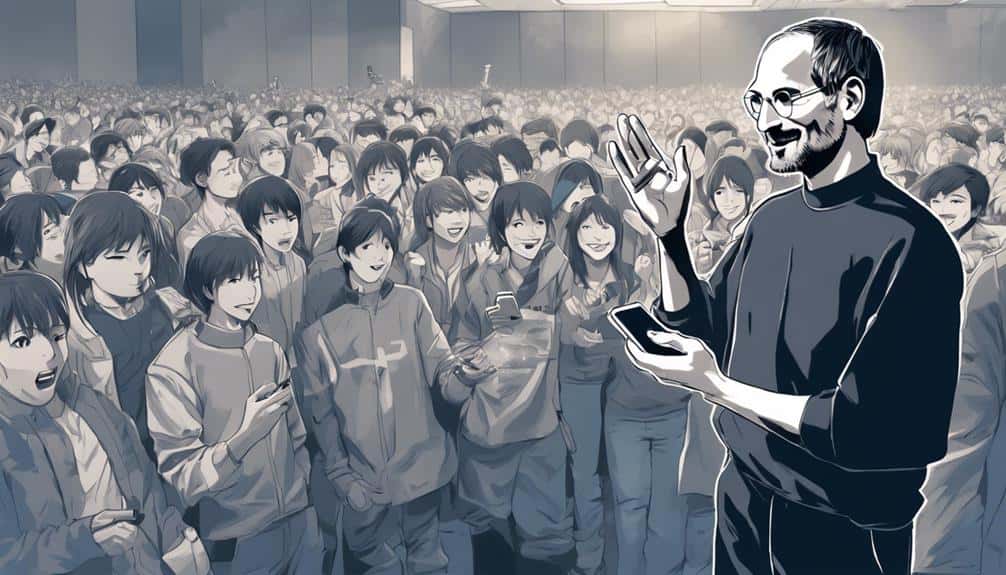
Imagine a community so dedicated, they feel a sense of identity through their products. That’s what Apple achieved, and you can too. Let’s dive into how.
Leveraging Design Innovation and Cultural Impact: Apple’s Blueprint for Community Building
Steve Jobs was a master at creating a loyal community. It wasn’t just about selling products; it was about creating an emotional bond. Here’s how he did it and how you can too:
1. Design Consistency:
Think about the Snow White design language, crafted by Hartmut Esslinger. It became Apple’s visual signature, a design language everyone could recognize. Consistent design builds a visual identity that your audience can rally around. ✅
2. Cultural Impact:
Jobs turned Apple into a cultural icon. The original Macintosh and the iPod weren’t just gadgets; they were cultural milestones. Position your brand in a way that it becomes a statement, not just a product. 🍏
3. User Identity:
Apple products aren’t merely tools; they’re an extension of the user’s self. This emotional connection fosters loyalty. Create products that resonate so deeply with your audience that they feel incomplete without them. ❤️
Practical Steps to Build Your Own Community
- Consistency is Key:
Keep your design language cohesive and recognizable. Your audience should be able to spot your brand from a mile away.
- Make a Cultural Statement:
Don’t just sell a product; sell a lifestyle. Make your brand something people want to be associated with.
- Forge Emotional Connections:
Your products should feel like an extension of the user’s identity. If they see themselves in your brand, they’ll stick around.
Ready to Build Your Own Loyal Community?
You can do it. It’s all about design, culture, and connection. Want to dive deeper into how you can achieve this? Let’s chat! Book a consultation call with me and let’s transform your brand into a cultural icon. 📞
Ready to take the next step? Click here to book your consultation call now! 📅
Memorable Launch Events
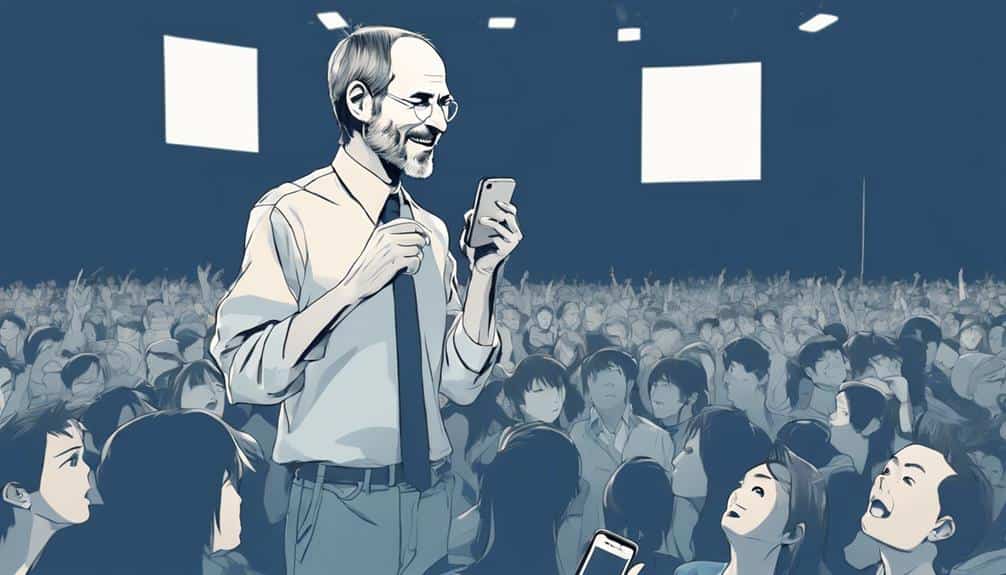
Ready to turn your brand’s launch into a cultural phenomenon? Let’s dive into the magic behind unforgettable launch events!
Creating a loyal community is just one piece of the puzzle. The real game-changer? Generating buzz through meticulously orchestrated launch events that catapult your brand to new heights.
Think of Apple’s legendary launch events—masterclasses in building anticipation and enthusiasm. Steve Jobs’ attention to detail was evident in every aspect, from the meticulously designed stage to the precisely timed reveals. These weren’t just presentations; they were experiences that left audiences in awe.
Data shows that the introduction of products like the iPhone and iPad at these events played a pivotal role in solidifying Apple’s reputation for innovation. The keynotes, often meticulously rehearsed, ensured a flawless presentation, leaving nothing to chance. This level of preparation translated into a seamless experience that resonated with both fans and the media.
Apple’s launch events became a cornerstone of its marketing strategy, drawing global attention. These events weren’t just about showcasing new products; they were about creating a narrative of exclusivity and state-of-the-art technology. By making each launch an event to remember, Apple effectively turned product releases into cultural moments, reinforcing its brand identity and strengthening its community’s loyalty.
Imagine your brand achieving the same level of impact. It’s not just about the product; it’s about the story you tell and the experience you create. Ready to make your next launch a game-changer? Let’s chat about how we can elevate your brand to iconic status. Book a consultation call with me today, and let’s make your brand unforgettable! 🚀
Iconic Branding
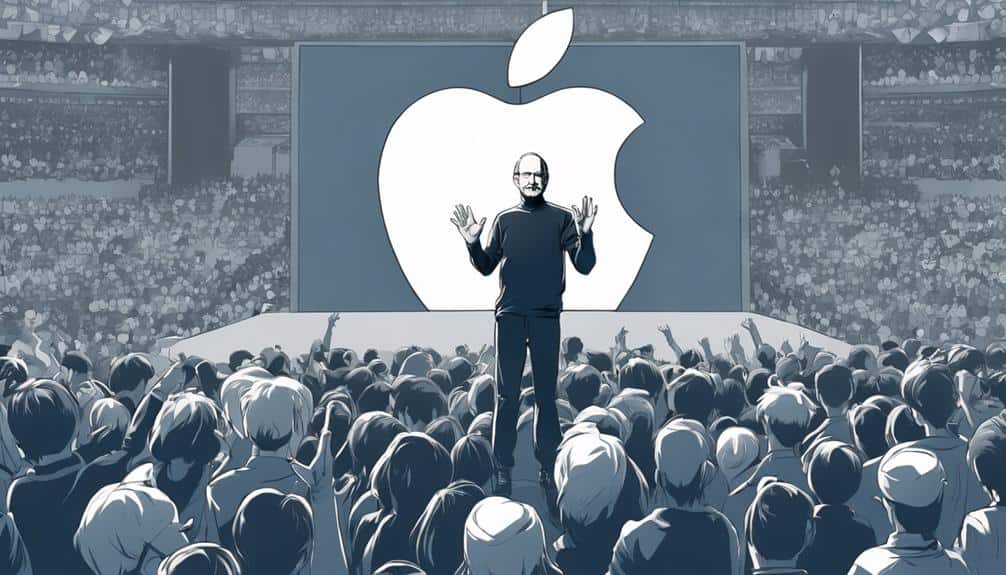
Ever wondered why you feel a personal connection to your iPhone? Let’s dive into Apple’s branding magic. Over the years, Apple has brilliantly tapped into ideals of individuality, creativity, and innovation to forge a deep bond with consumers. Steve Jobs was the mastermind behind this, intertwining his own persona with Apple’s identity, making their products feel intimate and personal. This wasn’t just luck; it was a calculated, data-driven strategy.
To understand how Apple became iconic, consider these key elements:
- Narrative of ‘Think Different’: The ‘Think Different’ campaign wasn’t just clever marketing; it was a battle cry for those who saw themselves as rebels and trailblazers. This narrative created a tribe of loyal fans who felt a strong sense of belonging.
- Design Excellence: Apple focused not just on looks but on a seamless, intuitive user experience. Their design philosophy made users feel smarter and more capable, elevating the brand above mere functionality.
- Mythic Qualities: By imbuing both the products and the company with almost mythic qualities, Steve Jobs fostered a near-religious devotion among fans. Apple products became more than just tools—they were extensions of the user’s identity.
Jobs’ genius lay in creating an emotional connection that transcended typical consumer relationships, turning customers into loyal advocates.
Want to learn how to create a brand that resonates on this level? Book a consultation call now, and let’s make your brand iconic. 🚀
Long-Term Vision
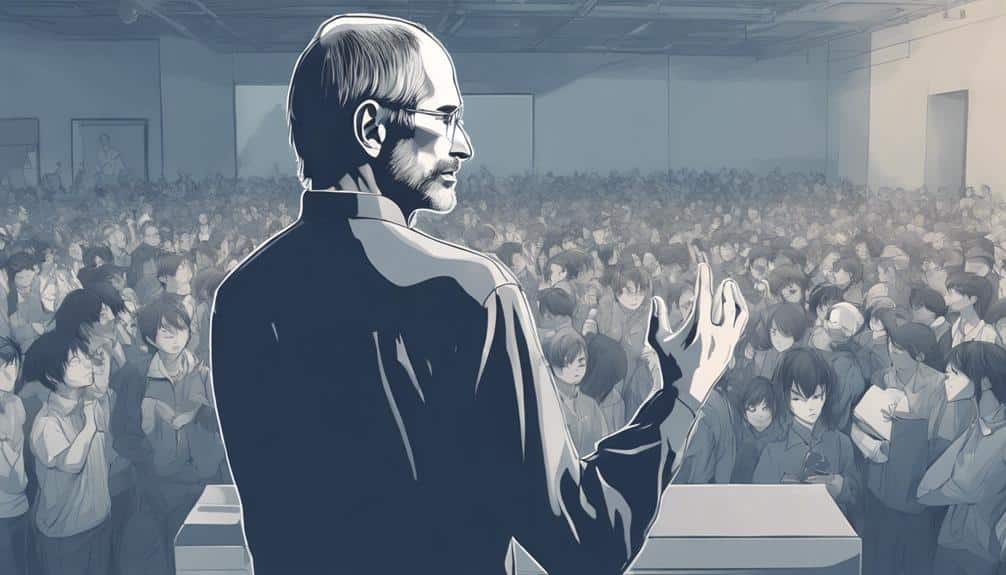
Apple’s long-term vision, driven by luminaries like Hartmut Esslinger, has laid the foundation for ongoing innovation and industry dominance. When Esslinger joined Apple in 1982, he introduced the revolutionary Snow White design language. Not just a pretty face, this design set new industry benchmarks and earned a spot in prestigious institutions like the Whitney Museum and MoMA.
Steve Jobs took Esslinger’s vision to heart, ensuring Apple products weren’t only technologically superior but also visually stunning. This strategy was key in positioning Apple as a leader in digital consumer tech. Esslinger’s push for classic design values and reconciling with Microsoft helped Apple skillfully navigate its competitive landscape.
Following Jobs to NeXT in 1985, Esslinger kept offering invaluable insights on design and market positioning. He demonstrated how design, innovation, and mass-market appeal could come together to create products that do more than just sell—they change the world. This visionary approach, steeped in cultural impact and foundational principles, helped Apple sustain its growth and influence, aligning perfectly with Steve Jobs‘s dream of changing the world.
This isn’t just a history lesson; it’s a blueprint for success. If you’re looking to elevate your brand and make a lasting impact, now’s the time. Let’s chat about how you can apply these timeless principles to your business.
Book your consultation call today and let’s start crafting your iconic brand. 🌟
